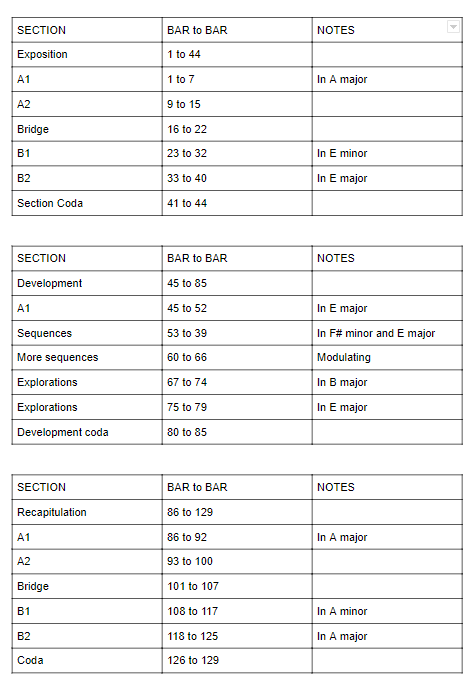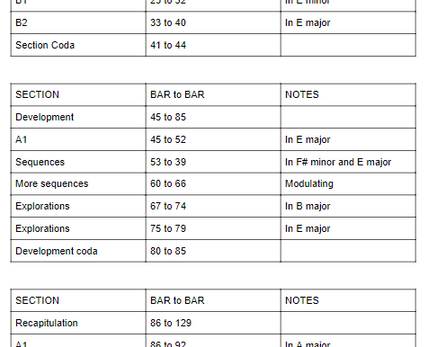Haydn Sonatas, Uncategorized
Haydn Sonata in A Major Hob. XVI.5 – Divertimento
This beautiful sonata reflect Joseph Haydn’s spirit the best.
https://www.youtube.com/watch?v=uvXE4ohCSE4
FIRST MOVEMENT
Let’s start with the very first bars of this Haydn Sonata:
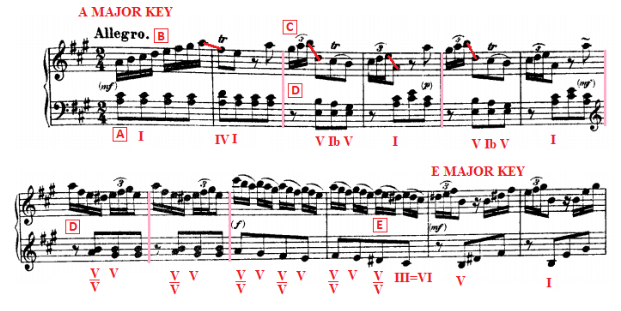
Some of the appreciations we may do about the main resources:
A) Thirds accompaniment. Widely used in all Haydn’s literature.
B) Opening ascending root key scale. Classical tradition.
C) Semiquavers triplet. Another signature resource from the composer, becoming a quintessential element in many Haydn pieces.
D) The power of the repetition: In between pink lines you may observe how the repetition is always the engine that keeps the music rolling in this period.
E) In less than two staves, we have already modulated: Now we are in E major key: the dominant key of the initial root A major.
Now, let’s observe some other details:
– Can you see the red lines in the first four bars? These red lines show us a composition style very used in the period. Fast ascending notes but, instead of reaching a peak by climbing, in the last moment we make a jump down.
– In bars 3 and 5 we can find parallel motions between the two top lines, all upon a dominant pedal. The middle chord work as a passing harmony, turning that IV degree into a repercussion IV degree.
– Sequences: In between bars 9 and 10: Isn’t this just the same thing repeated eight times in different parts of the keyboard?
– Harmonic interest: As we see in the second staff, the importance of the dominant of the dominant. Haydn’s intentions show a deep interest in establish E major as the root key in a very consistent manner.
We may believe that, after this second staff, we will start soon with a softer secondary theme in E major. But Haydn doesn’t feel ready yet. He really wants to settle down E major key. The next four staves develops largely the new tonality without adding a lot of new resources. We may organize this bridge in four ideas:
Bars 16 to 21: Sequences: A dominant and then the resolution. Three times. All with E major key chords and degrees. In bars 17, 19 and we lean on: minor relative, dominant, and root chord.

Then, in bars 22 – 25, we repeat these two simple bars twice. It sounds bright and novel and should be played with a bright and funny intention.
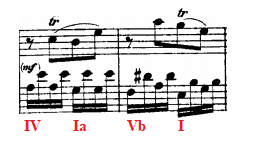
In bar 26, we start to stretch the voices, loading stress each bar, and with an intense crescendo we reach the Coda of this section.

In this coda, the harmony is very contundent. Plenty of perfect cadences lead us to the section end. The pianistic resources are quite limited, just using notes of the chord in different rhythm combinations to give some motion. The last four bars use a simple but extremely efficient chord embracing.

Overall, so far we play very little on A major. Most of the piece was unstable and in constant movement. The fifth degree, E major, is very important all the way through, as a destination key but also as the journey itself.
But when the secondary theme finally happens, it doesn’t start in E major key.
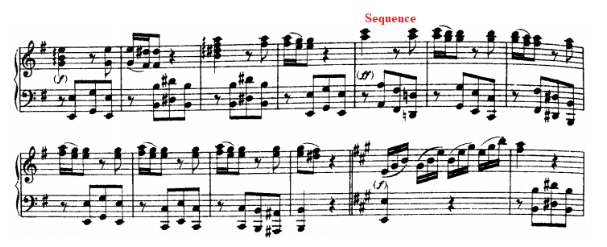
The secondary theme is first presented in E minor. The music will arrive to E major eventually, after a while. It’s a bit surprising to find the minor dominant here, but it works very well to add drama and something unexpected. It sounds somber but smart and elegant.
After two bars that are played twice, we arrive to a sequence: We can appreciate the left hand repeating the same pattern one note lower each time. The comeback to E major key is explosive and bright, stretching the sound of the ,,piano as we climb with that semiquaver triplets. Once we arrived, the next bars and simple and straightforward and lead us to a nice section-end.
The development starts, as in many other Haydn sonatas, repeating the main Theme in the dominant key we have arrived to. It’s a literal translation in the first six bars.

But after this, new resources arrive: links by two in the right hand, and more sequences. We can appreciate in the next image the different sequences shown in red and in pink. In red it’s marked the first part of the sequence, and in pink when we repeat that but in a different part of the keyboard to keep the harmony interesting, flowing, and in constant motion, as the development needs.
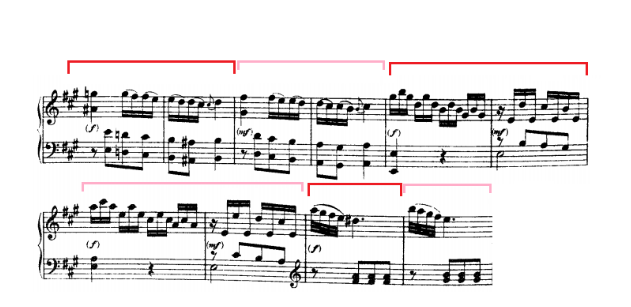
Immediately after we can find a passage that demands a lot of finger dexterity to be played in accurate manner, with crisp sound and graceful intention. That passage will lead us into a long sequence development. The first two bars are in the key of C#.

Haydn repeats these two bars many times going through many keys, such as:
F# minor. F# major, B minor, B major and finally E major, where Haydn settle down.
To finish this development, Haydn uses the same Coda he used for the Exposition, but this time in A major key. The same repeated bars to move back to the original key, the build in on the dominant, and finally, a lot of perfect cadences.
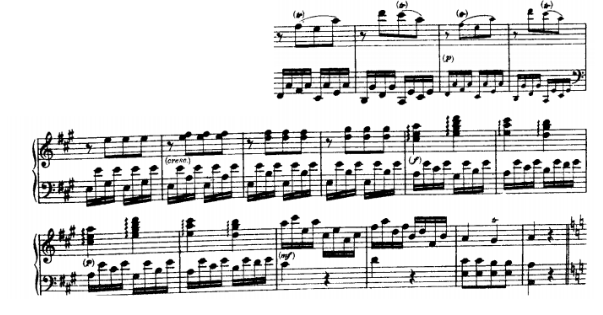
So, now we are expecting to hear the recapitulation. But Haydn surprises us again. Rather than play the A theme again, he jumps straight to the secondary theme, now in the root key but minor, hoping to go to the major key soon. This section is, also, like previous zones before, a exact transliteration of the secondary theme just in a different key. There isn’t anything different, there isn’t scope for modifications or variations. We can appreciate this in the comparison chart:
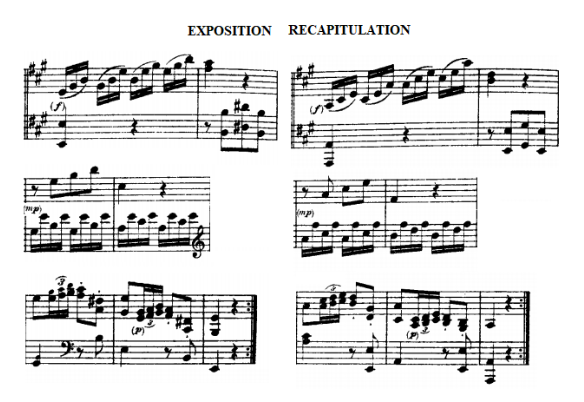
Overall, we can find some unusual things for a sonata, like the lack of a proper recapitulation (something very appreciated in this period), or the secondary theme first showing up in a minor version of the necessary key, or even a quite long development (53 bars against 62 of the Exposition, for instance).
These things are more likely in the Post-Beethoven period than in this early Haydn’s composition stage. The thirds and chords should be played with forearm movements, and the finger passages with a very clean and neat movement, to add colour with classical articulation. Other difficult part is in between bars 80 and 84, where we have to use a complex combination forearm movements to play the repeated notes and finger movement to play the quick ornamentations and thrills.
TECHNICAL NOTES:
The most demanding part is the Coda of each section, we have to play a fast succession of thirds. A good forearm movement is necessary to enter the keyboard and then we have to articulate our fingers in a very strict manner to play correctly the upcoming ones. If the thirds sound a bit broken or delayed, we lose the intention and we can’t play in the accurate character.
STRUCTURE:
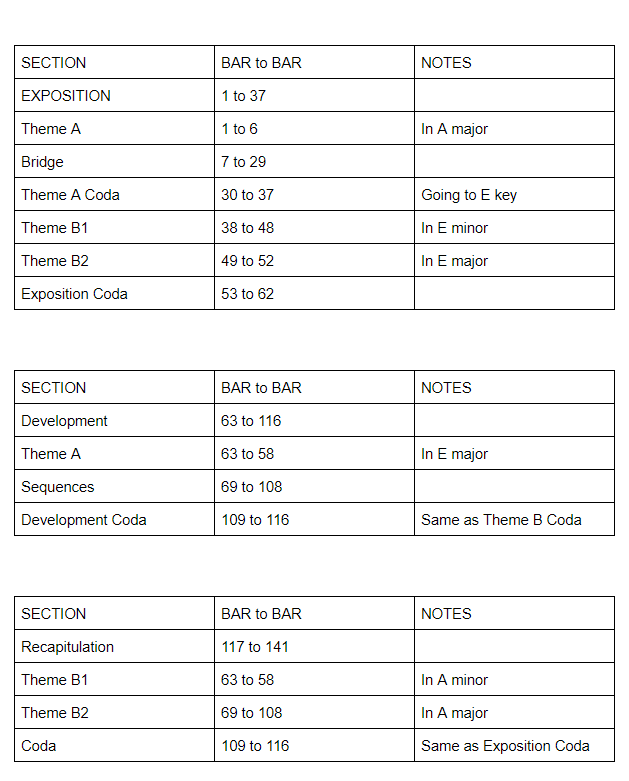
SECOND MOVEMENT – MINUET
The second movement is an ordinary and short Minuet.
The main theme is built with thirds, jumps, and traditional harmony. The second section shows the theme again, now in the dominant, but we come back to the initial root key before we finish. Less repetition than usual is shown up on this part, just bars 13-14 and 15-16.
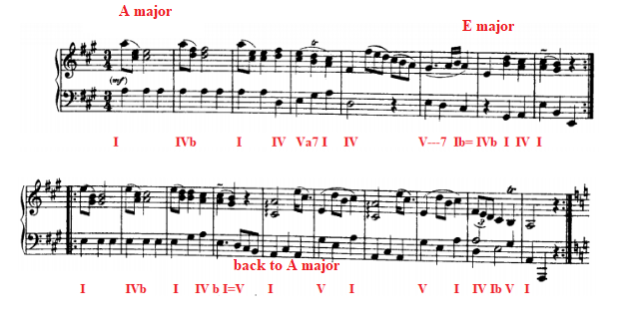
The Trio also uses one resource from the previous movement: starting the second section in the root key but minored. It makes some oscillations to the major relative of A minor: C major. The first section of this trio finishes up in C major key.
In the second part of the trio we have a little 4 bar sequence twice: the first time going to D minor (the IV grade of the key) and the second time going to C major.

There isn’t a lot more in this simple Minuet. Typical classical resources appears like perfect cadences, thrills, diminished chords resolving according to their leading-notes attraction, and a bass following all the rules of the period.
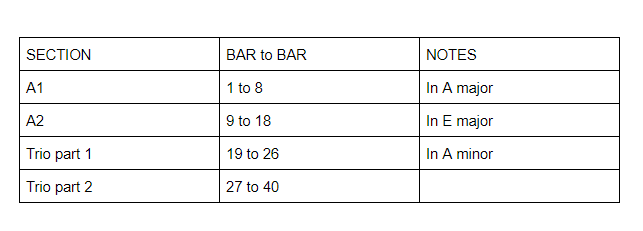
THIRD MOVEMENT – PRESTO
In Sonata form, a bit less twisted than the first movement, the number is short, fast and fancy.
It’s not a surprise to find on this movement the same old resources that make classical music so peculiar. In the first bars we can contemplate:
- Semiquaver triplet
- Thirds
- Jumps – Broken chord, harmony notes.
- Links by two
- Suspended chords to finish

If we take a very brief look to any other Haydn Keyboard work, we will find all these resources scattered there in different proportions. In this period we could find little margin to experiment or add extremely contrasting resources.
The second line is ruled again by broken chords in both hands, and semiquaver triplets.

Then, more repetitions and links by two.

And, to close this section, Haydn uses a sequence: each bar one note lower until he establishes E as the new key.
Like the first and second movement, the secondary theme is in a minor mode. This eloquent theme is very contrasting to the first one: Here we prioritize adjacent notes rather than jumps (just one jump happens here) and share the same structure (repeating the same first and third bar each one, with bars two and four slightly different- just some variation).
After a brief sequence, we face an intense and explosive variation: something like a combination of both main themes, in E major, full of life and spirit.
It takes from the A theme the triplet, the jumps and the broken chord idea
It serves from the B theme the thirds, the key, and the position in the piece.
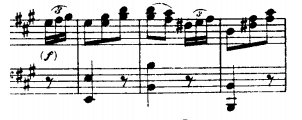
The development starts with the main theme in the dominant key: E major. Then, in a four-bar sequence, we go through the keys of F# minor and E major, passing across the dominant degrees too. The modulations don’t stop until we reach a B pedal, and then an E
pedal, both build in with intensity. In the last bar of the image, we can see a tremolo pedal and then a dominant degree resolving in the root, moving the leading notes according to its attraction. Isn’t it similar to ,,Beethoven’s ,,Pathetique sonata? Haydn’s heritage is immeasurable.

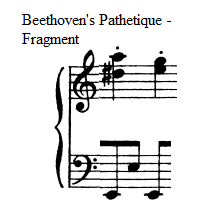
The most unusual thing happens towards the end of the development. When we finish the development in a classic sonata, usually we lean on the fifth grade, or we insinuate the come-back to the root. But in this situation, Haydn just finishes the section in a Third degree, the minor relative. And without further preparation, we go back to the main theme in A major. Again, this seems more likely to happen in Beethoven’s work than in Haydn’s.
The recapitulation arrives in bar 86 and it’s identical until the bar 92, when the left hand picks another exit and lead us to establish A as the main key rather than modulate.
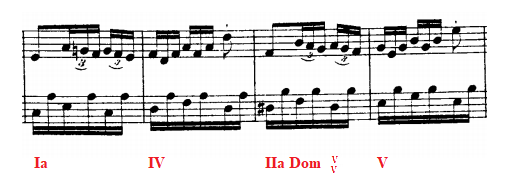
The secondary theme appears, naturally, in a minor mode, as a perfect transposition of the first part. We reach the major mode again in bar 118.
TECHNICAL NOTES:
This movement is the most difficult of the piece, demanding a high-standard finger dexterity. The articulation should be bright and even, practicing with intensity the sections that may need fourth and fifth finger rapid movement. The fingering should be carefully selected to prioritize the strong and fast fingers of both hands – but mainly the right. Some accompaniments in the left hand may be played with rotation movement, as it may work better than normal finger movement articulation due to the high tempo.
I personally recommend to use a non-legato touch when we have the fast rows of notes, like the semiquaver triplets and the scales. This specific way of playing will add the right amount of colour and clarity to the piece. Most of the quavers should be played detached with forearm movement.
OVERALL:
This sonata explores the idea of the secondary theme in minor to become major again on the go.
It’s a bit strange to pick the main tonality as minor, as normally the classic composers uses the minor relative as the first option.
The traditional key change would be from A major to F# minor.
But in this piece we go from A major to the fifth degree in minor mode: E minor
This allows to use the main key, A, first minor (and then major) in the Recapitulation.
The situation happens in all three movements. The minor section add drama and interest, catching you by surprise. Haydn pretends he is going to a major chord but suddenly he changes his mind, plenty of times.
Analysing other factors, the second and third movements are very traditional, with not many attempts to cross the line in the experimentation field.
In the first movement, in contrast, the suppression of a normal recapitulation of the main theme it’s unusual and responds to an earlier concept on the music structures that were slowly decaying at the time.
